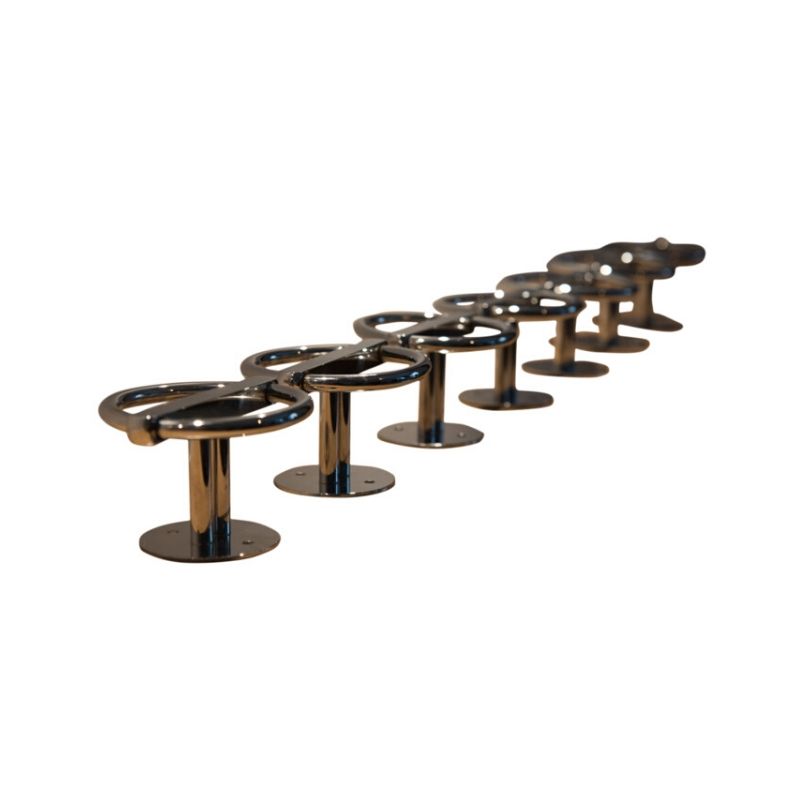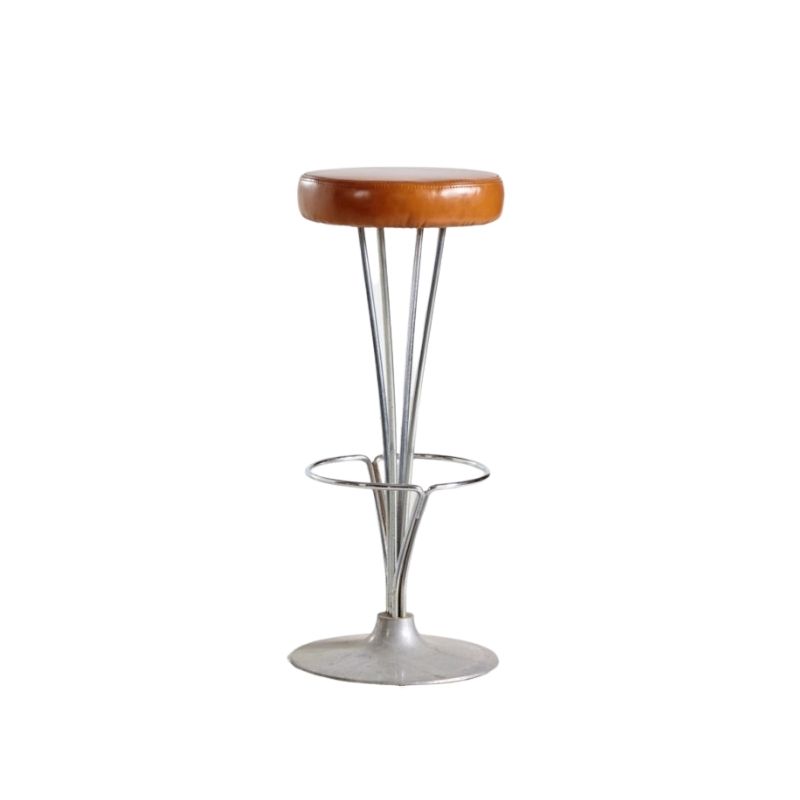conservation not restoration
Your chair looks perfect and in very good condition. Just leave it alone and enjoy the piece as found. Unless it is absolutely falling apart every time someone touches it then go ahead and do some repairs to make it usable, just don't over do it. Something that's over 60 years old should look its age unless you like the look of an old matron that had a facelift/nip tuck. I have 2 yellow stained DCM's from the first year and only 9 was ever produced out of hundreds and thousands of the other finishes and discontinued early on because of the low order. It is not perfect, the chrome has some pitting, there are some minor finish loss and lost a couple of the original glides but it is expected for its age. If you do not like the vintage used look, let it go and give it to someone who does and get yourself a perfect and sleek brand new version.
Also, looking at the shape of the metal frame that holds the back piece, this is an early Herman Miller version, the older ones made by Evans are round in shape with a hole in the center.
Wow, thanks all for all the...
Wow, thanks all for all the super useful comments! I'm very glad I came here for advice, as my local antique furniture expert I consulted just looked at me scornfully when I said I wanted to keep the original finish, then proceeded to start sanding the surface to show me what he would do! Fortunately he didn't have time to do visible damage before I stopped him.
On the conservation vs restoration front, I must apologize deeply for the misunderstanding. Conservation would have been a much more specific term for what I want to do. In my non-English native language "restoration" can refer either to bringing back to like-new condition, or just maintenance and protection, in particular for a piece that has been neglected. I am now better informed, even though the distinction is not always clear-cut between the two.
I did not think twice about cleaning the chrome base of my chair to remove the extensive rust. The chrome is still pitted, which is fine by me, but I would like to avoid further rust coming in if possible. Similarly, I would imagine that it can be desirable to remove "aftermarket" paint drops from the existing finish, but I'm not sure how to do that in a way that is safe to the finish. Finally, it was not clear to me whether any standard maintenance can be used to enhance durability and appearance of the wood, without compromising the chair's character. I.e., I want to conserve the character of the chair, but I don't want to neglect it/allow unnecessary damage to it!
So I think the facelift analogy might be a bit strong. I would say that I received someone who was covered in blood and dirt, with a broken limb. I fixed the limb and cleaned up the blood, and now I'm looking for advice on how to deal with the dirt and disinfect the wounds...
Cheers, and thanks again for all the advice!
--iltuje.
Right.
The trade-off is between doing nothing beyond dusting, and preserving the patina -- even down to the paint spots, which sound charming to me, offsetting or complementing the worn-through places ? -- or waxing or clear-coating after spot removal, etc, adding luster and improving cleanability/wearablilty, at the expense of the original untouched patina.
I couldn't make that choice. A museum or another collector would no doubt want to receive it with nothing added or taken away. But you intend to keep and use the chair, I take it. Salud.
EAMES CATALOGUE RAISONNE
There is nothing wrong with restoration but it is the last resort for pieces as you described it "covered in blood and dirt, with a broken limb", there are books on Eames furniture and Herman Miller catalog reprints everywhere that describes the finishes on these chairs in detail. Check out the Eames Office Gallery website also if you really want to learn about the Eames work particularly the DCM ( http://www.eamesoffice.com/eames-furniture-raisonne) and click on any one of the DCM examples they have. If you can make the piece look good for its age and it still looks like nothing was done to it, that's the best complement a restorer can get just don't forget to disclose it when you are ready to part with your chair. Good luck with you endeavor!
A thorough cleaning got rid...
A thorough cleaning got rid of most of the paint drops and the grime, and I'm pretty happy with the looks of the chair as-is. The glue job also worked out well. So thanks to all for the support!
I'm still a bit concerned about areas of the chair where the wood looks thirsty (see pic, taken with a flash at low-angle to emphasize issues), and I wish there was a way to protect the chair against further damage that didn't offend so many sensibilities 🙂
Anyhow, I'll give it a try as-is for a little while, and if I am still concerned, I'll start looking for the least invasive way of adding some degree of protection.
Cheers
Assistance
I redid a whole bunch of old chairs and I have some advice for you:
They will look better restored, but this will probably effect the resale value. In some instances it can increase the value if done well.
The chairs I redid had their value substantially increased - and they look brilliant.
You have several key issues to deal with, the chairs I dealt with were plywood layers with a veneer on the top - I assume yours are, too.
First thing to do is take extensive photographs outside of the chair so you can record the exact tone of the chair color - or research on-line to see how they looked originally.
This advice is if you want to get them looking super flash.
Remove the mounts. Have them coated in an oil to restore the rubber to a palliable texture and re-hydrate the rubber.
Mark on the wood where the mounts are to go. My advice is to use a slightly smaller circle to mark the wood - use a nail head to lightly circle the wood. You want this so sanding will not erase the line - this is why you should use a smaller circle - only slightly. If there are stickers do not try to remove, you will destroy them. Cover them with plastic sheet and tape around them.
Time to strip it down. Use the Jaco stuff at home depot/lowes. It is serious stuff. It will rip the surface junk off. Have plenty of rags around and wipe it/rub it off very well. DO NOT let it dry up, put it on thick - obviously you have detached the wood from the frame before you do this.
Once that is done, use mineral spirits to take away any residue.
Let it dry half an hour.
Time to sand. DO NOT under any circumstance use a belt sander! The whole chair has to be done by hand sanding. You may find after stripping down that some other fellow before you tried to redo it - and left sanding marks. Maybe not.
part three
Follow the instructions and get 4-6 coats of it on there - very light. I do not sand between coats because I do not put it on thick - light coats are superior to thick coats. Use a brush of super high quality - this is not a time to go cheap - spend $20 on a brush and keep it soaking in brush cleaner between use - obviously get the brush cleaner off before reusing and stir the brush into the polyurethane to mix in any paint/brush cleaner left deep in the bristles.
Lite coats please - can't say this enough. It will get to a finish that looks like a car if you just show patience.
Once done you will be left with beautiful wood that will look like a show room finish and bring it back to its former glory.
Now use a quality epoxy - nothing cheap to get the mounts back on. Use a proper good one - spend the money and use a small amount but evenly coated - mount failures happen most when epoxy is put on unevenly and pressure is incorrectly applied by sitting on it.
As for the frame, use chrome rust remover & polisher - use lots of rags and use elbow grease - never ever use a pad or anything but cotton cloths or terry towels. Never use a scouring pad.
Reassemble and enjoy.
part two of restoring
If there are no sanding marks, then go straight to grit 100 and sand it down. Do not overdo one area. Typically veneer is very thin so you will have about 1/32 of an inch to work with - which is actually a lot. DO NOT use a sanding pad because this applies pressure to the edge of the pad when it passes over a curved surface and you will have portions of the veneer sanded more than others - which can result in penetration = you've wrecked it. By hand all the way and follow the grain in every case.
Once this is done, redo mineral spirits - why? Because mineral spirits will "lift the grain" and show you deep sand marks you will not see with the naked eye. It literally is an index to what the finish will look like. If they are found, sand using the 100 until they go away.
Next use 150 grit and go over the surface, then 180. Once you are at this point you can opt to also go to 220 - this will give you a very mirror like surface.
A good test at this point is to take a piece of the underside and now clean with mineral spirits and after half an hour, put polyurethane on a patch. Why? Because some wood will automatically give you a rich finish - like walnut which can look light until you apply polyurethane.
After it has dried (4 hours) judge for yourself - either decide to do the whole thing without staining if the finish is excellent.
If you decide to stain then make sure you get an expert to match the stain - take the wood and test near the area you polyurethaned.
Do the stain lightly. Wipe if off the little area immediately and allow to dry and 8-12 hours later do it again etc until you reach the desired stain depth. Never ever let stain sit on the wood surface because it the acts like paint rather than stain. Wipe it on, then wipe it off. Better to do several stains then a thick one.
Once you have got the stain to the desired point excellent, now take it off with sanding as well as the polyurethane patch. You need the while surface done as one.
Apply wood conditioner and let it settle overnight.
Stain as needed - and for gods sake do not rush it - let it dry a day between each light stain - and very very very important ensure every time you stain the stain has been thoroughly stirred right down to the bottom of the can. If you do not, you will not have the same stain color because some of the components of stain settle in the bottom of the can.
Once you have the stain done, now polyurethane.
A LITE coat! The first coat is designed to seal the wood, not give you a finish.
Perform a simple test.
On the underside of the seat, place a drop of denatured alcohol, let it sit for a minute, then blot it with a clean white rag or paper towel. If any color comes off, or if the spot feels sticky, apply a paste wax and call it good. If the remaining finish seems unaffected by the alcohol, it's probably safe to put on a coat or two of shellac, of which there are many grades and colors and is easily "reversible" without deleterious effect to the underlying original finish. I like "dewaxed blonde" mixed fresh from dry flakes. Do a little poking around on the web for info on shellac. Products from Behlen's or J.E. Moser are trustworthy.
Don't apply "oil" to rubber. Nothing restores dried-out rubber and petroleum products can often be harmful.
Minimoma's posts are worth rereading, as are the numerous thoughtful posts in this thread.
I think the chair looks great, but I don't like a dry, unprotected surface either. What's the point of having old things if they appear brand-new?
If you need any help, please contact us at – info@designaddict.com









